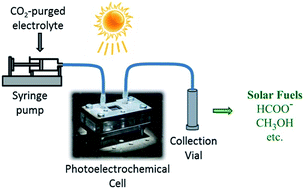A microfluidic photoelectrochemical cell for solar-driven CO2 conversion into liquid fuels with CuO-based photocathodes
Abstract
Utilising photoelectrochemical (PEC) devices to produce sustainable fuels from water and CO2 is a very attractive strategy, in which sunlight is used to convert the greenhouse gas (CO2) into a usable form of stored chemical energy. While significant progress has been made in the development of efficient photoactive catalysts for PEC reactions, limited efforts have been focused on the reactor design where continuous flow microfluidic PEC reactors are particular promising. In this work, a range of CuO-based thin films were used as photocathodes in a continuous flow microfluidic PEC reactor using CO2-saturated aqueous NaHCO3 solution under simulated AM 1.5 solar irradiation for up to 12 h. The highest photocurrent density obtained was for the α-Fe2O3/CuO photoelectrode yielding −1.0 mA cm−2 at 0.3 V vs. RHE and initial results indicated a solar-to-fuel (STF) efficiency of 0.48%. While the CuO, Cu2O and CuO–Cu2O photoelectrodes virtually only formed formate, the bilayer α-Fe2O3/CuO photocathode produced methanol in addition to formate indicating that combined copper and iron oxides in continuous flow microfluidic PEC cells have great potential of direct solar conversion into useful chemicals.

- This article is part of the themed collection: Artificial photosynthesis


 Please wait while we load your content...
Please wait while we load your content...